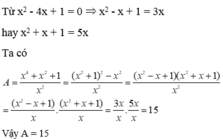Tính giá trị biểu thức A = x 4 + x 2 + 1 x 2 biết x 2 - 4 x + 1 = 0
Hãy nhập câu hỏi của bạn vào đây, nếu là tài khoản VIP, bạn sẽ được ưu tiên trả lời.



a) A = (x - 5)(x² + 5x + 25) - (x - 2)(x + 2) + x(x² + x + 4)
= x³ - 125 - x² + 4 + x³ + x² + 4x
= (x³ + x³) + (-x² + x²) + 4x + (-125 + 4)
= 2x³ + 4x - 121
b) Tại x = -2 ta có:
A = 2.(-2)³ + 4.(-2) - 121
= 2.(-8) - 8 - 121
= -16 - 129
= -145
c) x² - 1 = 0
x² = 1
x = -1; x = 1
*) Tại x = -1 ta có:
A = 2.(-1)³ + 4.(-1) - 121
= 2.(-1) - 4 - 121
= -2 - 125
= -127
*) Tại x = 1 ta có:
A = 2.1³ + 4.1 - 121
= 2.1 + 4 - 121
= 2 - 117
= -115

\(a,ĐK:x\ne\pm2\\ A=\dfrac{4x-8+2x+4-5x+6}{\left(x-2\right)\left(x+2\right)}=\dfrac{x+2}{\left(x-2\right)\left(x+2\right)}=\dfrac{1}{x-2}\\ ĐK:x\ne-1;x\ne-2\\ B=\dfrac{x+1}{\left(x+1\right)\left(x+2\right)}=\dfrac{1}{x+2}\\ b,x^2+x=0\Leftrightarrow\left[{}\begin{matrix}x=0\left(tm\right)\\x=-1\left(tm\right)\end{matrix}\right.\\ \forall x=0\Leftrightarrow A=\dfrac{1}{0-2}=-\dfrac{1}{2}\\ \forall x=-1\Leftrightarrow A=\dfrac{1}{-1-2}=-\dfrac{1}{3}\)
\(x^2+2x=0\Leftrightarrow\left[{}\begin{matrix}x=0\left(tm\right)\\x=-2\left(ktm\right)\end{matrix}\right.\Leftrightarrow x=0\\ \Leftrightarrow B=\dfrac{1}{0+2}=\dfrac{1}{2}\)

Bài 5:
a: Thay \(x=4+2\sqrt{3}\) vào E, ta được:
\(E=\dfrac{\sqrt{3}+1-1}{\sqrt{3}+1-3}=\dfrac{\sqrt{3}}{\sqrt{3}-2}=-3-2\sqrt{3}\)
b: Để E<1 thì E-1<0
\(\Leftrightarrow\dfrac{\sqrt{x}-1-\sqrt{x}+3}{\sqrt{x}-3}< 0\)
\(\Leftrightarrow\sqrt{x}-3< 0\)
hay x<9
Kết hợp ĐKXĐ, ta được: \(\left\{{}\begin{matrix}0\le x< 9\\x\ne1\end{matrix}\right.\)
c: Để E nguyên thì \(4⋮\sqrt{x}-3\)
\(\Leftrightarrow\sqrt{x}-3\in\left\{-2;1;2;4\right\}\)
\(\Leftrightarrow\sqrt{x}\in\left\{4;5;7\right\}\)
hay \(x\in\left\{16;25;49\right\}\)
Câu 2:
a) Ta có \(x=4-2\sqrt{3}\Rightarrow\sqrt{x}=\sqrt{\left(\sqrt{3}-2\right)^2}=\sqrt{3}-2\)
Thay \(x=\sqrt{3}-1\) vào \(B\), ta được
\(B=\dfrac{\sqrt{3}-1-2}{\sqrt{3}-1+1}=\dfrac{\sqrt{3}-3}{\sqrt{3}}=1-\sqrt{3}\)
b) Để \(B\) âm thì \(\dfrac{\sqrt{x}-2}{\sqrt{x}+1}< 0\) mà \(\sqrt{x}+1\ge1>0\forall x\) \(\Rightarrow\sqrt{x}-2< 0\Rightarrow\sqrt{x}< 2\Rightarrow x< 4\)
c) Ta có \(B=\dfrac{\sqrt{x}-2}{\sqrt{x}+1}=1-\dfrac{3}{\sqrt{x}+1}\)
Với mọi \(x\ge0\) thì \(\sqrt{x}\ge0\Rightarrow\sqrt{x}+1\ge1\Rightarrow\dfrac{3}{\sqrt{x}+1}\le3\Rightarrow B=1-\dfrac{3}{\sqrt{x}+1}\ge-2\)
Dấu "=" xảy ra khi \(\sqrt{x}+1=1\Leftrightarrow x=0\)
Vậy \(B_{min}=-2\) khi \(x=0\)

Bài 1) Chứng minh rằng các biểu thức sau luôn có giá trị âm với mọi giá trị của biến:
a) 9x^2+12x-15
=-(9x^2-12x+4+11)
=-[(3x-2)^2+11]
=-(3x-2)^2 - 11.
Vì (3x-2)^2 không âm với mọi x suy ra -(3x-2)^2 nhỏ hơn hoặc bằng 0 vơi mọi x
Do đó -[(3*x)-2]^2-11 < 0 với mọi giá trị của x.
Hay -9*x^2 + 12*x -15 < 0 với mọi giá trị của x.
b) -5 – (x-1)*(x+2)
= -5-(x^2+x-2)
=-5- (x^2+2x.1/2 +1/4 - 1/4-2)
=-5-[(x-1/2)^2 -9/4]
=-5-(x-1/2)^2 +9/4
=-11/4 - (x-1/2)^2
Vì (x-1/2)^2 không âm với mọi x suy ra -(x-1/2)^2 nhỏ hơn hoặc bằng 0 vơi mọi x
Do đó -11/4 - (x-1/2)^2 < 0 với mọi giá trị của x.
Hay -5 – (x-1)*(x+2) < 0 với mọi giá trị của x.
Bài 2)
a) x^4+x^2+2
Vì x^4 +x^2 lớn hơn hoặc bằng 0 vơi mọi x
suy ra x^4+x^2+2 >=2
Hay x^4+x^2+2 luôn dương với mọi x.
b) (x+3)*(x-11) + 2003
= x^2-8x-33 +2003
=x^2-8x+16b + 1954
=(x-4)^2 + 1954 >=1954
Vậy biểu thức luôn có giá trị dương với mọi giá trị của biến

a, Khi x = 2, ta được:
\(A=\dfrac{4}{2\sqrt{2}-2}=2+2\sqrt{2}\)
b, \(B=\dfrac{\sqrt{x}-4}{x-2\sqrt{x}}+\dfrac{3}{\sqrt{x}-2}\\ \Rightarrow B=\dfrac{\sqrt{x}-4+3\sqrt{x}}{\sqrt{x}\left(\sqrt{x}-1\right)}\\ \Rightarrow B=\dfrac{4\left(\sqrt{x}-1\right)}{\sqrt{x}\left(\sqrt{x}-1\right)}\)
\(P=B:A=\dfrac{4\left(\sqrt{x}-1\right)}{\sqrt{x}\left(\sqrt{x}-1\right)}\cdot\dfrac{\sqrt{x}\left(2-\sqrt{x}\right)}{4}=-\left(\sqrt{x}-1\right)=1-\sqrt{x}\) (đpcm)

a: \(A=\left[\left(\dfrac{4x}{x+2}+\dfrac{8x^2}{4-x^2}\right)\right]:\left[\dfrac{x-1}{x^2-2x}-\dfrac{2}{x}\right]\)
\(=\left(\dfrac{4x}{x+2}-\dfrac{8x^2}{\left(x-2\right)\left(x+2\right)}\right):\left(\dfrac{x-1}{x\left(x-2\right)}-\dfrac{2}{x}\right)\)
\(=\dfrac{4x\left(x-2\right)-8x^2}{\left(x+2\right)\left(x-2\right)}:\dfrac{x-1-2\left(x-2\right)}{x\left(x-2\right)}\)
\(=\dfrac{-8x}{\left(x-2\right)\left(x+2\right)}\cdot\dfrac{x\left(x-2\right)}{x-1-2x+4}\)
\(=\dfrac{-8x^2}{\left(x+2\right)\cdot\left(-x+3\right)}\)
\(=\dfrac{8x^2}{\left(x-3\right)\left(x+2\right)}\)
b: \(x^2+2x=15\)
=>\(x^2+2x-15=0\)
=>(x+5)(x-3)=0
=>\(\left[{}\begin{matrix}x+5=0\\x-3=0\end{matrix}\right.\Leftrightarrow\left[{}\begin{matrix}x=-5\left(nhận\right)\\x=3\left(loại\right)\end{matrix}\right.\)
Thay x=-5 vào A, ta được:
\(A=\dfrac{8\cdot\left(-5\right)^2}{\left(-5-3\right)\left(-5+2\right)}=\dfrac{8\cdot25}{\left(-8\right)\cdot\left(-3\right)}=\dfrac{25}{3}\)
c: |A|>A
=>A<0
=>\(\dfrac{8x^2}{\left(x-3\right)\left(x+2\right)}< 0\)
=>(x-3)(x+2)<0
TH1: \(\left\{{}\begin{matrix}x-3>0\\x+2< 0\end{matrix}\right.\)
=>\(\left\{{}\begin{matrix}x>3\\x< -2\end{matrix}\right.\)
=>\(x\in\varnothing\)
TH2: \(\left\{{}\begin{matrix}x-3< 0\\x+2>0\end{matrix}\right.\)
=>\(\left\{{}\begin{matrix}x< 3\\x>-2\end{matrix}\right.\)
=>-2<x<3
Kết hợp ĐKXĐ, ta được: \(\left\{{}\begin{matrix}-2< x< 3\\x\notin\left\{0;2\right\}\end{matrix}\right.\)

a) Ta có: \(P=\dfrac{x-2}{x^2-1}-\dfrac{x+2}{x^2+2x+1}\cdot\dfrac{1-x^2}{2}\)
\(=\dfrac{x-2}{\left(x-1\right)\left(x+1\right)}-\dfrac{x+2}{\left(x+1\right)^2}\cdot\dfrac{-\left(x-1\right)\left(x+1\right)}{2}\)
\(=\dfrac{x-2}{\left(x-1\right)\left(x+1\right)}+\dfrac{\left(x+2\right)\left(x-1\right)}{2\left(x+1\right)}\)
\(=\dfrac{2\left(x-2\right)}{2\left(x-1\right)\left(x+1\right)}+\dfrac{\left(x-1\right)^2\cdot\left(x+2\right)}{2\left(x-1\right)\left(x+1\right)}\)
\(=\dfrac{2x-4-\left(x^2-2x+1\right)\left(x+2\right)}{2\left(x-1\right)\left(x+1\right)}\)
\(=\dfrac{2x-4-\left(x^3+2x^2-2x^2-4x+x+2\right)}{2\left(x-1\right)\left(x+1\right)}\)
\(=\dfrac{2x-4-\left(x^3-3x+2\right)}{2\left(x-1\right)\left(x+1\right)}\)
\(=\dfrac{2x-4-x^3+3x-2}{2\left(x-1\right)\left(x+1\right)}\)
\(=\dfrac{-x^3+5x-6}{2\left(x-1\right)\left(x+1\right)}\)
\(=\dfrac{-\left(x^3-5x+6\right)}{2\left(x-1\right)\left(x+1\right)}\)